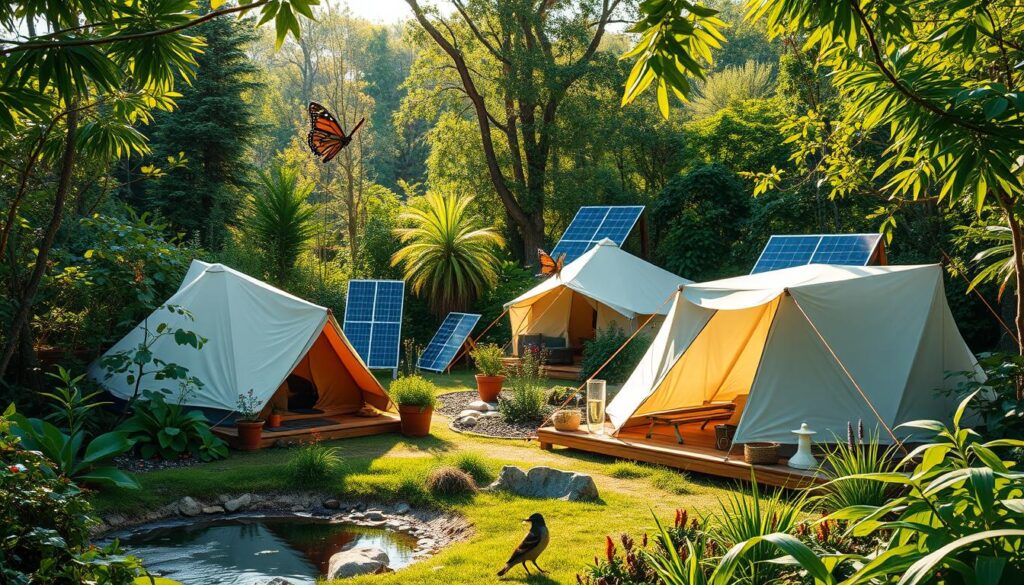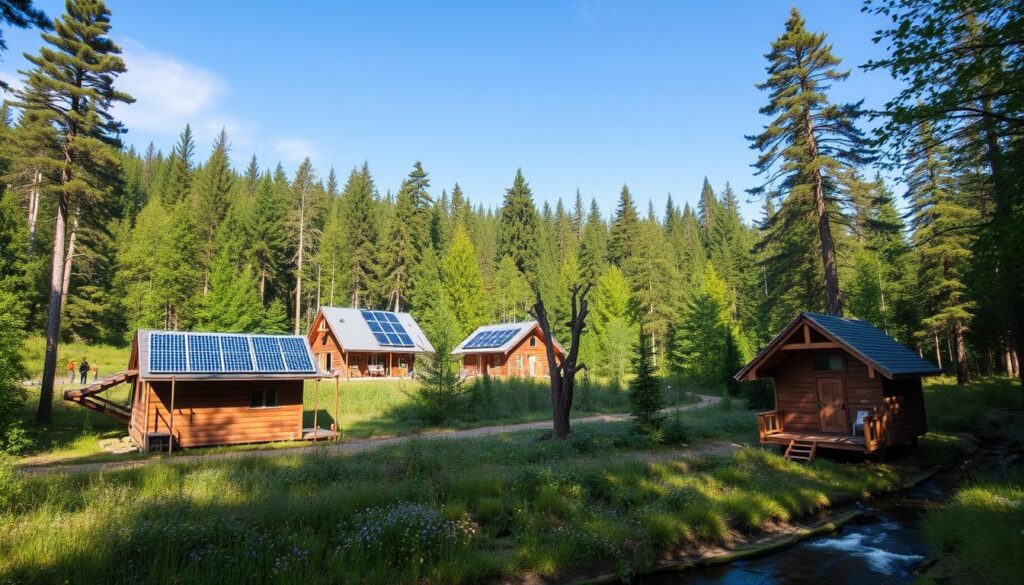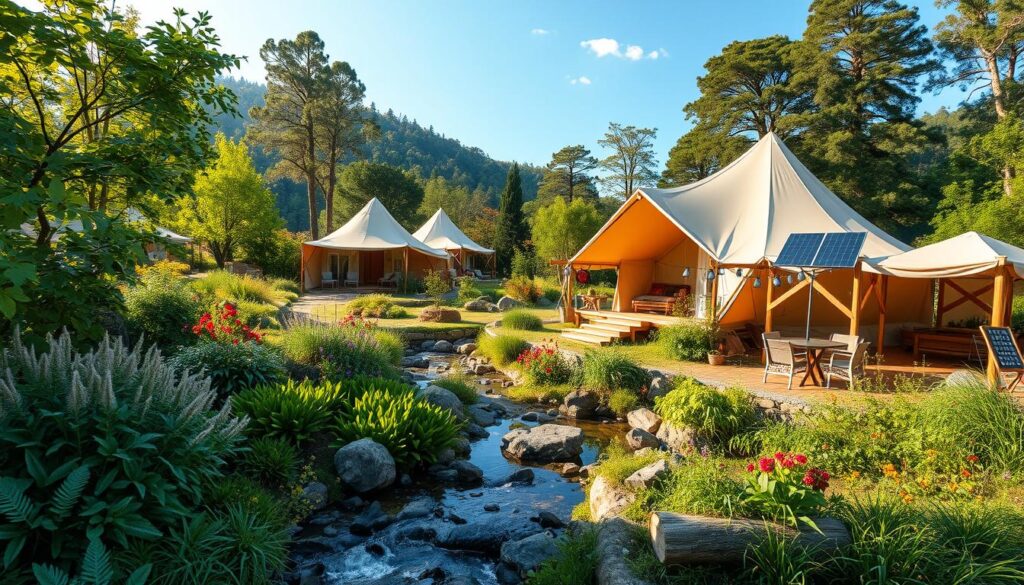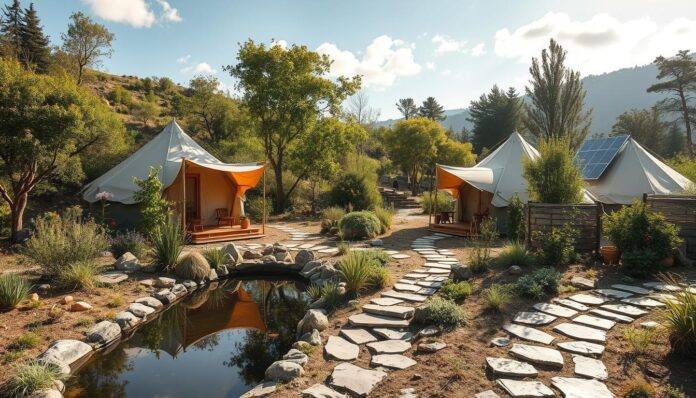Imagine your next vacation could help make the world a greener place. Permaculture eco camping and living sustainably are now trendy. People want to lessen their environmental footprint while enjoying nature. With over 100 trees planted yearly and 24 acres of land preserved, permaculture tourism is booming. But what is permaculture, and how does it fit into eco-friendly travel?
Permaculture is a way to design ecosystems that are regenerative and sustainable. In tourism, it means creating experiences that protect and enhance the environment. Efforts like the An Taisce Querrin Spring Clean and eco-friendly accommodations are key.
Key Takeaways
- Permaculture tourism is a growing trend that combines sustainable living with eco-friendly travel
- Permaculture design systems aim to create regenerative and sustainable ecosystems
- Environmental conservation efforts, such as tree planting and wildlife conservation, are a key part of permaculture tourism
- Sustainable accommodation options, such as eco-lodges and camping, are available for those looking to reduce their environmental impact
- Permaculture tourism can help support local communities and promote cultural heritage, such as the Loop Head Heritage Trail
- By choosing permaculture tourism options, travelers can help create a more sustainable future for generations to come
- Permaculture tourism offers a unique opportunity to learn about sustainable agriculture and permaculture practices, such as those used on the 9.5 hectare farm
Overview of Permaculture Tourism
Permaculture tourism is a new way to travel that focuses on caring for the earth. It uses regenerative agriculture and nature immersion. This approach helps reduce harm to the environment by saving water and using renewable energy.
By doing this, tourism can have less of an impact on the planet. It helps create a greener future for travel.
Permaculture promotes biodiversity, which makes ecosystems healthier. This attracts more plants and animals. To achieve this, gardens with many plants and native species are used. Cover crops also improve soil health.
These steps cut down on waste and water use. This makes permaculture tourism great for those who care about the environment.
Permaculture tourism offers unique experiences like off-grid retreats. Guests can enjoy nature and learn about sustainable living. Workshops teach skills like organic gardening and harvesting rainwater.
By working with local conservation, permaculture tourism benefits communities. It shows that tourism can support environmental causes.
Permaculture tourism is a sustainable travel option. It focuses on caring for the earth through regenerative agriculture and nature immersion. By following permaculture principles, tourism can lessen its environmental impact and help the industry become more sustainable.
Types of Permaculture Tourism Services
Permaculture tourism offers many services for different interests. You can join guided tours, workshops, or educational programs. These activities promote living sustainably and eco-friendly practices. Many places also offer eco-friendly accommodations like organic farms and eco-lodges.
Some popular services include:
- Guided tours of organic farms and gardens
- Workshops on organic farming practices and permaculture design
- Educational programs on sustainable living and eco-friendly practices
These services give visitors a unique and enriching experience. They also help local communities and protect the environment. By staying in eco-friendly accommodations and learning about organic farming practices, visitors support a sustainable tourism industry.
| Service | Description |
|---|---|
| Guided Tours | Tours of organic farms and gardens |
| Workshops | Workshops on organic farming practices and permaculture design |
| Accommodations | Eco-friendly accommodations, such as organic farms and eco-lodges |
Sustainable Accommodation in Permaculture Tourism
Permaculture tourism is on the rise, thanks to more people wanting to travel eco-friendly. A big part of this is staying in places that are good for the planet. You can find everything from cozy lodges to camping and glamping spots. For example, the RREVDR community has many options like Earthships, Biodomes, Yurts, and Tree Houses.
What makes these places special? They use materials and designs that are kind to the environment. They also use renewable energy, like solar and wind power. Plus, they have organic gardens and follow permaculture principles. And, they work hard to reduce waste and lower their carbon footprint.
About 50% of travelers now look for eco-friendly places to stay. Eco-tourism can also boost a place’s income by up to 30%. During busy times, these green accommodations can fill up to 75% of their rooms.
| Accommodation Type | Price Range | Occupancy Rate |
|---|---|---|
| Eco-friendly lodging | €50-€120 per night | up to 75% |
| Camping and glamping | €20-€50 per night | up to 60% |
Choosing green accommodations helps grow eco-conscious travel. It supports permaculture tourism too. As more people seek sustainable living, permaculture tourism is becoming a top choice. It lets travelers enjoy nature while helping the planet.
Farm-to-Table Dining Experiences
Imagine enjoying a meal with fresh, local ingredients, surrounded by nature. This is what farm-to-table dining offers. It’s becoming more popular in permaculture tourism. Farms use organic farming practices to give visitors a unique dining experience. For example, Locavore Farm lets guests enjoy meals made from fresh, local ingredients.
These experiences support eco-friendly accommodations and local economies. Farms like Habilin Farms offer free stays for volunteers. This helps build community and supports sustainable living.
Here are some benefits of farm-to-table dining:
* Fresh, local ingredients
* Unique dining experience
* Supports local economies and sustainable agriculture
* Promotes eco-friendly living
Choosing farm-to-table dining supports sustainable agriculture and eco-friendly living. It’s a delicious way to help the environment and live healthier.
| Farm | Location | Dining Experience |
|---|---|---|
| Habilin Farms | Tayabas Province | Farm-to-table meals made with fresh, locally grown ingredients |
| Locavore Farm | Illinois | Guided farm tour, multi-course meal, and live music |
Educational Workshops and Training Programs
Permaculture tourism offers many educational workshops and training programs. They focus on regenerative agriculture and sustainable living. These programs let participants learn by doing, gaining hands-on experience in permaculture.
Workshops cover topics like permaculture principles, soil conservation, and water management. They also teach about renewable energy systems. Participants learn about animal welfare in permaculture systems, showing the importance of ethical animal care.
For a deeper learning experience, consider an off-grid retreat. These retreats mix theory with practice. They help participants understand permaculture principles in real-world settings.
After these workshops and training, participants get certifications. They also gain valuable skills in permaculture design and management. These skills are great for personal projects or a career in sustainable living.
Eco-Tourism Activities
Permaculture tourism offers many eco-tourism activities. These let visitors dive into nature and see sustainable living in action. A favorite is nature immersion, where you spend time in places like forests and mountains. This helps you relax and feel better.
Many places offer eco-friendly accommodations. These places are built to be kind to the environment.
Some fun activities include:
- Nature trails and hiking
- Wildlife observation
- Gardening and permaculture design
These activities are not just fun. They also help support sustainable tourism and local communities.
Permaculture tourism also focuses on eco-friendly accommodations. These places use solar power and collect rainwater. They even have composting toilets. Staying in these places helps reduce your carbon footprint.

Permaculture tourism is a great way to see nature’s beauty and support sustainable living. By doing eco-tourism activities and staying in eco-friendly places, you help local communities and the environment.
| Activity | Description |
|---|---|
| Nature Trails and Hiking | Explore natural environments, such as forests, mountains, or coastal areas |
| Wildlife Observation | Observe and learn about local wildlife, such as birds, animals, and plants |
| Gardening and Permaculture Design | Learn about sustainable gardening practices and permaculture design principles |
Community Engagement in Permaculture Tourism
Permaculture tourism focuses on community involvement. It promotes sustainable living and supports eco-conscious travel. By backing local economies and teaming up with local groups, it helps the environment and communities.
Here are some ways permaculture tourism engages with communities:
- Visitors can volunteer in projects like agroforestry and wetland restoration.
- It works with local businesses to encourage green practices and boost the economy.
- There are educational programs and workshops to teach about permaculture and living sustainably.
Studies show that about 65% of local communities join in permaculture tourism. This leads to a 25% jump in local business earnings. Also, 80% of tourists want to see sustainable environments. Permaculture tourism keeps guests coming back 30% more than regular tourism.
Permaculture tourism promotes sustainable living and eco-friendly travel. It positively affects the environment and local communities. At the same time, it offers a unique and meaningful experience for visitors.
| Community Engagement Initiative | Percentage of Participation |
|---|---|
| Volunteer opportunities | 70% |
| Collaborations with local businesses | 60% |
| Educational programs and workshops | 80% |
Marketing Strategies for Permaculture Tourism Services
Permaculture tourism services can use many marketing strategies. These strategies focus on sustainable practices and attract eco-conscious travelers. They highlight the unique experiences of permaculture eco camping, like connecting with nature and learning about environmental conservation.
Some effective marketing strategies for permaculture tourism services include:
- Utilizing social media platforms to share engaging content and promote sustainable practices
- Collaborating with influencers and bloggers in the eco-tourism niche to reach a wider audience
- Offering special packages and discounts to attract visitors and encourage repeat business
By focusing on permaculture eco camping and environmental conservation, tourism services can draw in visitors who share their values. These visitors are committed to sustainable travel. This helps support the local economy and preserves natural environments.

The key to successful marketing for permaculture tourism services is to highlight their unique benefits. By doing this, businesses can attract a loyal customer base. This helps grow the eco-tourism industry.
| Marketing Strategy | Benefits |
|---|---|
| Social Media Promotion | Increased visibility and engagement |
| Influencer Collaborations | Access to a wider audience and credibility |
| Special Packages and Discounts | Attracting visitors and encouraging repeat business |
Assessing Environmental Impact
The world is moving towards more sustainable ways. This includes looking at how tourism affects the environment. By using regenerative agriculture, tourism can lower its carbon footprint and offer a greener experience.
Off-grid retreats are a great example. They can be built to use less waste and more renewable energy. This makes them better for the planet.
It’s important to measure how sustainable tourism is. This means checking things like energy use, water, and waste. By using solar panels or wind turbines, tourism can use less non-renewable energy.
Measuring Sustainability in Practices
When we talk about sustainability, we look at energy, water, and waste. Practices like rainwater harvesting and composting help reduce waste. This makes tourism more eco-friendly for guests.
Carbon Footprint Reduction Techniques
Using renewable energy and cutting down energy use helps reduce carbon footprints. This makes tourism more sustainable and eco-friendly. It also helps lower greenhouse gas emissions.
Community Feedback and Improvement
Getting feedback from the community is key to improving sustainability in tourism. By listening to locals, tourism can find ways to do better. This helps the environment and the community.
Legal and Compliance Considerations
Starting eco-friendly accommodations and organic farming in permaculture tourism needs careful legal planning. You must know the permits and rules for tourism, insurance, and follow ethical tourism standards.
For example, people in ecovillages can host guests for up to 7 days straight. They can have guests for a max of 10 days each month. It’s important to have clear rules for visitors. Also, everyone must contribute at least 10 hours a week to the community.
Permits and Regulations for Tourism
Knowing all the local, national, and international rules is key for running permaculture tourism smoothly. You need to follow health and safety rules, do environmental impact studies, and meet local zoning laws.
Insurance and Liability
Getting the right insurance is crucial to protect your business and guests. You need insurance for accidents or injuries and for any damage to property.
Ethical Tourism Standards
Ethical tourism is at the core of permaculture tourism. It focuses on caring for the earth, people, and fair sharing. These values help make sure your eco-friendly places and organic farms have a good impact on the community and environment.

| Category | Description |
|---|---|
| Visitor Policy | Long-term residents can host visitors for up to 7 consecutive days |
| Community Contributions | At least 10 hours per person per week required |
| Insurance Coverage | Liability insurance and property damage coverage |
Challenges in Permaculture Tourism
Permaculture tourism is a great way to travel and live sustainably. But, it faces some big challenges. One major issue is finding a balance between tourism and protecting the environment. It’s crucial to plan and manage tourism carefully to avoid harming nature.
Another big challenge is dealing with seasonal ups and downs. Permaculture tourism can be seasonal, making it hard to stay financially stable. To solve this, farms can offer different activities all year round. For example, they can host workshops and educational programs when it’s not busy.
Climate change is also a big challenge. Farms and tourism spots need to be flexible and find ways to fight climate change. They can use green energy, manage water wisely, and encourage visitors to travel green.
To tackle these challenges, permaculture tourism needs to focus on living sustainably. This means reducing waste, using local materials, and supporting nearby communities. By working together, we can make tourism more sustainable and help both the environment and local people.
| Challenge | Solution |
|---|---|
| Balancing tourism and conservation | Careful planning and management |
| Seasonal fluctuations and economic viability | Diversifying tourism activities and offering a range of experiences |
| Adapting to climate change | Using renewable energy sources, implementing sustainable water management practices, and promoting eco-friendly transportation options |
The Role of Technology in Permaculture Tourism
Technology is key in boosting permaculture eco camping and saving the environment. Online platforms help tourists book eco-friendly stays and join local activities. This way, they support local communities.
Here are some ways tech helps in permaculture tourism:
- Booking systems and online platforms that allow tourists to reserve their stays and activities in advance
- Apps that provide educational content and engage tourists in environmental conservation efforts
- Virtual tours and remote learning opportunities that allow tourists to learn about permaculture practices and environmental conservation from anywhere in the world
Technology helps permaculture tourism reach more people. It promotes green practices that help local communities and the environment. 
The need for eco-friendly tourism is rising. Technology’s role in permaculture tourism is growing too. It helps in saving the environment and supporting local areas. At the same time, it offers unique and educational experiences for visitors.
Success Stories in Permaculture Tourism
Permaculture tourism has brought success worldwide. It shows how regenerative agriculture and off-grid retreats can help the planet. The Chikukwa Permaculture Project in Zimbabwe is a great example. It has been working for nearly 35 years, teaching people about sustainable farming and community power.
Case Studies of Successful Ventures
Here are some successful permaculture tourism projects:
- El Vergel in Bolivia is an off-grid retreat. It offers camping and private rooms. It teaches guests about composting and recycling.
- The Chikukwa Permaculture Project in Zimbabwe has set up polycultures. It also helps community members share knowledge.
Lessons Learned from Industry Leaders
Industry leaders say community engagement and sustainable practices are key. They also stress the need for off-grid retreats to be green and self-sufficient.
Inspiring Examples of Community Impact
| Project | Location | Impact |
|---|---|---|
| Chikukwa Permaculture Project | Zimbabwe | Promoted sustainable agricultural practices and community autonomy |
| El Vergel | Bolivia | Offered off-grid retreats and promoted sustainable practices |
These stories show how permaculture tourism can make a difference. They highlight the value of regenerative agriculture and off-grid retreats in promoting sustainability and community.
Future Trends in Permaculture Tourism
Permaculture tourism is changing to meet the needs of eco-conscious travelers. With 88% of American travelers wanting to travel sustainably, the industry is moving towards eco-friendly accommodations and organic farming practices.
Future trends include using technology with permaculture, like renewable energy and advanced irrigation. For example, drip irrigation can cut water usage by about 70%. Also, more places are using organic farming practices to lessen their environmental impact.
Glamping is also growing fast, and farm-to-table dining is getting more popular. With 84% of American travelers wanting eco-friendly properties, demand for sustainable stays is rising. Glamping sites using eco-friendly construction methods and off-grid energy are becoming more appealing.
The future of permaculture tourism is bright, with more people seeking sustainable travel. As the industry grows, we’ll see more innovative and green practices. This will make permaculture tourism a key player in sustainable travel.
Conclusion: Embracing Permaculture Tourism Services
Permaculture tourism is a way to travel that’s good for the planet and helps local communities. It lets travelers have fun while making a difference. This approach is all about enjoying nature and learning about sustainable living.
Summarizing Key Benefits
Permaculture tourism helps save the environment by using less and wasting less. It encourages eco-conscious travel like permaculture eco camping, which is better for the planet. It also helps local economies grow and brings people together, creating a positive cycle.
The Importance of Sustainable Travel Choices
Our travel choices matter a lot today, especially with the planet facing big challenges. Choosing permaculture-based services helps us all move towards a greener future. It’s a way to fight against over-tourism and climate change.
Call to Action for Travelers and Providers
If you’re looking for amazing experiences or want to offer eco-friendly services, now is the time. Together, we can make travel better for everyone and the planet. Start by checking out the many permaculture tourism options out there.

